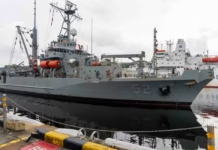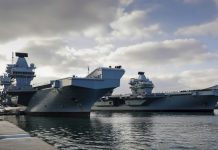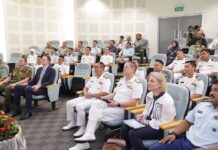
After a hiatus of a couple of years the popular ‘Shiphanding Corner’ returned in the Spring 2001 edition of the Journal of the Australian Naval Institute. The still relevant first entry was on the Anzac class frigate by the new segment editor Commander, later Vice Admiral Ray Griggs.
The Anzac Class Frigate
This article has been complied from a number of sources in an attempt to provide the most up to date shiphandling perspectives about the Anzac class FFH.
While it is important not to lose sight of the fact that the FFH is not that dissimilar to either a DE or DDG in the basic way she behaves, there are some differences that make it worthwhile examining some of the shiphandling intricacies.
Even though the FFH have been in RAN service for over five years there is little harm in a quick refresher about the ship we are talking about. The basic shiphandling related facts are as follows:
- Displacement: 3600 tonnes
- Length: 118 metres
- Beam: 14.8 metres
- Draught: 4.5 metres
- Ship’s Company: 164
- Propulsion Plant: CODOG – One General Electric LM 2500 gas turbine and two MTU diesels driving two shafts with controllable pitch propellers and a single rudder.
Flexibility is the key to the FFH propulsion plant. The LM 2500 turbine was designed for sprint operations and delivers a maximum speed in excess of 27 knots (gas turbine operations are conducted in GT mode). The two MTU diesels deliver around 20 knots at full power and are used for the vast majority of the time (this is termed Diesel Engine or DE Mode). The cross connect gearbox which facilitates the CODOG configuration will allow either the LM 2500 or a single MTU to drive one or both shafts. However, the LM2500 is generally never used to drive a single shaft due to the risk of over tourquing.
A single MTU driving both shafts will allow the ship to reach around 12 knots, this is known in FFH parlance as Economy (or ECO) Mode. The big advantage of single MTU operations (apart from fuel economy and extended range) is of course the reduction in radiated noise and the subsequent enhancement in the ship’s Undersea Warfare (USW) capability, particularly with a tail deployed. Ship radiated noise can be further reduced by entering Silent (SIL) Mode, which despite the further speed limitations this brings with it (around 6 knots), the FFH becomes an even more stealthy platform for passive USW surveillance.
The whole machinery plant is controlled by the Control and Monitoring (or C&M) system. The C&M system has a significant number of measurement points of all key parts of the propulsion, power generation and distribution, auxiliary and damage control systems. It permits remote operation of a wide range of equipment in the unmanned machinery spaces with only three MCR personnel closed up. Changing modes is a fairly straightforward evolution and while it does require steady revolutions for the period of the transfer, this rarely takes more than 90 seconds to achieve.
The LM2500 and MTU diesels are contained in separate engineering spaces and further, are all housed in separate containers which reduces the risk of the spread of fire and assists in survivability.
The flexibility in the plant has significant get home advantages. In Anzac‘s initial sea trials in 1995 for example the ship entered Port Phillip Bay with one MTU driving the opposite shaft due to equipment defects sustained during the rigorous trials process. In any other ship in the RAN, the ship would not have been able to enter confined waters under her own steam.
The most obvious difference from a design perspective in the FFH is the screw/rudder configuration. In recent years most, if not all, of our twin screw frigates and destroyers have also had twin rudders positioned directly astern of the appropriate screw (I would appreciate any examples of unusual configurations the RAN has had in the past and your experiences with them). In the main the screws have been outward turning. In a FFH the screws are inward turning, the propellers controllable pitch and only a single centreline rudder is fitted.
The most immediate impact this has is that the ship is more sluggish at slow speed (less than 5 knots) and at least 20° of wheel is required to give effect to minor alterations of course. While this is common in all ships with very little way on, it is more pronounced in a FFH than in comparable size ships. When going ahead with adequate way on however, the ship steers well, the inward turning screws providing the necessary wash over the rudder. The debate over the screw and rudder configuration, and the associated paddlewheel effect is interesting, assuming of course that propeller action is a topic that captivates you.
For the average shiphandler the amount of turning moment which can be contributed to the fore and aft thrust versus the sideways forces of the screws is of no consequence. As long as there is a turning moment that allows the ship to be turned at rest then what else matters? In the FFH turning at rest is, in the final analysis, like any other twin screw ship – engines opposed and full rudder; slight headway will of course assist the process considerably. The ship is just a little less responsive – it has been described by one FFH CO as like manoeuvring a DDG stuck in mud!
When the ship is making sternway however, her manoeuvrability is more problematic. In all but the most benign conditions the stern will aggressively seek the wind. Above about 15 knots of breeze even opposing the engines and using full rudder is unlikely to halt the march to the wind.
Having a controllable pitch propeller is nothing startling these days but it does mean that you have to at least consider what is happening when you bring an engine to “Stop”. FFG shiphandlers are well versed in the effect of the spinning disc; most FFH shiphandlers tend to avoid stop and go from ahead directly to astern and vice versa. Rather than keep an engine stopped for prolonged periods of time, a small amount of power is applied (3-5%) as appropriate.
An important design issue in the ship is that the gas turbine was only planned for around 300 hours use a year and the diesels for the remainder of the ship’s operating profile. The rationale behind this was linked very much to through life maintenance and cost considerations rather than operational ones. Marine diesels are of course best used at constant (nearly full) load. This works well in merchant ships and larger auxiliaries where frequent speed changes for station keeping are not required as often. Marine diesels are susceptible to thermal stresses and overload during these regular and short changes in power. If these stresses are ignored, the result is of course increased wear, maintenance, downtime and costs.
To overcome the potential limitations in using marine diesels, all FFH shiphandlers have to be aware of the loads that the engine has been under. The recent load history will classify the engines as either cool, warm or hot. Depending on how the engine is classified will dictate how quickly and by how much power can be increased. While this sounds like a significant limitation planning on the shiphandler’s part easily compensates for it.
Engine orders are given in percentage terms of full power for the Gas Turbine (ie. 27 knots). For each different recognised C&M system mode there are specific ranges that can be set on the Power Control Lever (PCL). When using both diesels (in DE mode) for example, full power is approximately 73% of the maximum speed in GT mode. This then is the maximum setting that the C&M system will recognise. The maximum astern setting on the PCL in all major modes is 50%. This does not mean that it is only half of available astern power but that it would equate to an astern speed of about 13.5 knots. An order outside of the prescribed range for the particular mode (eg. Ordering Both Engines ahead 95% whilst in DE mode) will have no adverse impact as the C&M system will set the correct limit.
The format for engine orders is ‘Port/Starboard/Both Engines Ahead’Astern xx %’. The only trick to remember that an astern % will give about half of the effect of an ahead one. To turn at rest for example one might order ‘Port Engine ahead 10%, Starboard engine astern 20%, Starboard 30’. This will roughly balance the forces and slight adjustments are then easily made.
One of the key differences between the DE/DDG and the FFH is the impact of considerably more ‘sail’ area (the hangar being the largest contributor) and the comparatively shallow draught. Windage becomes a major planning consideration, particularly when the sluggish rudder performance is taken into account at slow speed.
Like a DDG the FFH’s flared bow can lead to the shiphandler being deceived and pulling up short and wide of the berth; only experience can overcome this one.
Replenishment operations are fairly straightforward although there are two clear points of view on whether a FFH should RAS in GT mode. Regulations permit a RAS in either DE or GT modes. For me the redundancy issue is foremost and my preference is for DE mode. The key issue is one of relative speed – if the RAS speed is 13-15 knots then it is unlikely that a FFH will achieve a speed differential of more than 5-6 knots during the approach. This of course increases the time spent in critical interaction zones. This risk can easily be mitigated by a more prudent and wider approach. It might not be as macho, but the result is the same. I certainly view GT mode for a RAS as a backup mode only. At least the ship has such a flexible plant to allow this discussion to take place at all.
The Anzac class frigate is still a delight to handle, as much for its challenges as its handiness. The shiphandler must have a thorough understanding of the ship’s systems and design to handle her smartly and that can’t be a bad thing.
About the Author
Vice Admiral Ray Griggs AO CSC RAN first contributed to the ANI Journal as a Lieutenant taking umbrage over something a senior officer had written. He specialised in navigation and navigated five ships. At the time of writing this article Ray Griggs was commanding the Anzac class frigate HMAS Arunta. The ship under his command would go on to undertake border protection duties (Operation Relex) and then deploy to the Arabian Gulf (Operation Slipper).
Ray Griggs joined the ANI Council in 2000 becoming Vice President in 2005 only relinquishing that role when he became Chief of Navy in 2011. Over the next few years he covered a wide range of topics from ship handling on operations, manned model simulation and navigational requirements in Defence’s procurement processes. He retired from the Navy in 2018 having served as the Vice Chief of the Defence Force.



